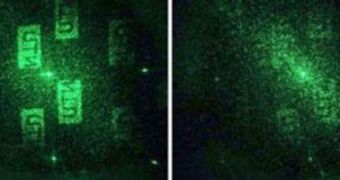A team of scientists in Singapore created a new device that can store holograms with the help of an electronically controlled crystal film. With some improvements, this could become a storage medium for increased amounts of data in small areas.
Holographic memory is a technology used to store amounts of information at high density inside crystals or photopolymers. Todays' storage techniques like DVDs use multiple layers to store information in the volume. Both techniques share an information density limit given by the used wavelength. In case of point-wise information retrieval this is called diffraction (of the writing beams).
The use of this holographic memory promises great advantages, like storing more information than the best DVDs by encoding it in three dimensions, in the form of light interference. However, the existing holographic data disks are not yet rewritable.
Xiaowei Sun and Liu Yanjun at Nanyang Technological University, Singapore, created a device that promises to be the next step in rewritable holographic memory disks. It contains a 7-millimeter square cell with an 8-micron-thick layer of liquid crystal and polymer inside.
Using computer generated holography, they were able to calculate the interference pattern, which greatly simplifies the recording process. A single laser is used to record a hologram by modifying the alignment of rod-like liquid crystal molecules spread throughout the polymer. A second laser beam can then be used to read the stored image.
Then, the team applied a voltage that forced the liquid crystal molecules realign, which temporarily wiped the recording that reverted to its original state after the removal of the voltage.
"The function is like a transistor,"said Sun, "instead of turning a current on or off, it is switching a holographic image."
This process looks promising and it will be possible to integrate the hologram into normal electronic applications.

 14 DAY TRIAL //
14 DAY TRIAL //